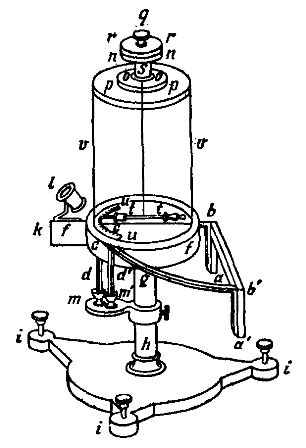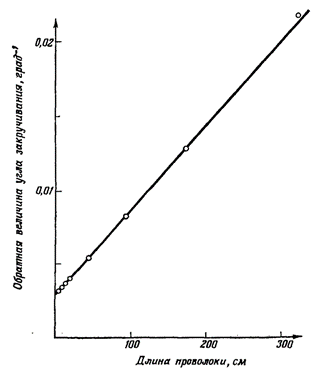The story of how Georg Simon Om discovered Ohm's law
 Ohm's law looks so simple that the difficulties that had to be overcome in establishing it are overlooked and forgotten. Ohm's law is not easy to verify, and it can not be regarded as an obvious truth; Indeed, for many materials, oh is not satisfied.
Ohm's law looks so simple that the difficulties that had to be overcome in establishing it are overlooked and forgotten. Ohm's law is not easy to verify, and it can not be regarded as an obvious truth; Indeed, for many materials, oh is not satisfied.
What are these difficulties? Is it not possible to verify what gives a change in the number of elements in the voltaic column, determining the current for a different number of elements?
The fact is that when we take a different number of elements, we change the entire chain, because additional elements have additional resistance. Therefore, it is necessary to find a way to change the voltage without changing the battery itself. In addition, a different current raises the wire to a different temperature, and this effect can also affect the current. Om (1787-1854) overcame these difficulties, taking advantage of the phenomenon of thermoelectricity, which was discovered by Seebeck (1770-1831) in 1822.
The phenomenon is observed when heating the junction of two different materials: a small voltage is excited, which can create a current. Seebeck discovered this effect by experimenting with plates of antimony and bismuth, and as a current detector used a coil with a large number of turns, inside which was inserted a small magnet. Seebeck observed the deflection of the magnet only when he gripped the plates with each other with his hands, and soon realized that the effect gave the warmth of his hand. Then he began to heat the plates with a lamp and got a much greater deviation. Seebeck did not fully understand the effect he discovered, and called it "magnetic polarization."
Om used the thermoelectric effect as a source of electromotive force. With the temperature difference unchanged, the voltage of the thermocouple must be very stable, and since the current is small, no appreciable heating should occur. In accordance with these considerations, Om manufactured the device, which, apparently, should be considered the first real device for research in the field of electricity. Prior to this, only crude instruments were used.

The Ohm's device for determining the current and resistance of the current.
The upper cylindrical part of the Ohm device is a current detector - torsion scales, ab and a'b '- thermoelements made of two copper wires soldered to a transverse rod of bismuth; M and m '- cups with mercury, to which it was possible to connect thermoelements. A conductor was connected to the cups, the ends of which were cleaned each time before they were immersed in mercury.
Om was aware of the importance of the purity of materials. Om held the junction in boiling water, and the junction a 'was lowered into a mixture of ice and water and observed the deflection of the galvanometer.
Typical German thoroughness and attentive attention to detail, characteristic of Om, can be countered by the almost boyish enthusiasm that Faraday displayed in his work. In physics, both approaches are necessary: the latter usually gives impetus to the study of a question, and the first is required to study it thoroughly and build a rigorous theory on the basis of precise quantitative results.
Om used eight conductors of copper wire of various lengths as conductors. At first, he could not get reproducible results, but a week later he apparently adjusted the device and received a series of readings for each of the conductors. These samples were the angles of twisting of the hanging wire, at which the needle returned to zero. Om showed that with proper choice of the constants A and B, the length x and the twisting angle X of the thread are connected by the relation X = (A / B + z)
We can illustrate this relationship by constructing a plot of x versus 1 / X.

Graph based on Ohm results
Om repeated his experiment with a brass wire and obtained the same result for a different value of A and the same value of B. He took for temperatures of 0 and 7.5 ° at Reamyur (9.4 ° C) for junctions of the thermoelement, and found that the deviations Decreased by about 10 times.
Thus, if we assume that the voltage that the device gives is proportional to the temperature difference - as we now know, this is approximately true, - it turns out that the current is proportional to this voltage. The ohm also showed that the current is inversely proportional to a certain value, which depends on the length of the wire. Om called it resistance, and it should be assumed that the value of B is the resistance of the rest of the chain.
Thus, Om has shown that the current is proportional to the voltage and inversely proportional to the total resistance of the circuit. This was a remarkably simple result for a complex experiment. So at least it should seem to us now.
Oma's contemporaries, especially his countrymen, believed otherwise: perhaps it was the simplicity of Ohm's law that aroused their suspicion. Om faced difficulties in his career, felt need; Especially oppressed Oma is that his works were not recognized. To the credit of the UK, and in particular of the Royal Society, it must be said that Oma's work received deserved recognition there. Om is one of those great people whose names are often written with a small letter: the name "ohm" was assigned to a unit of resistance.
G. Linson "Great experiments in physics"



Comments
When commenting on, remember that the content and tone of your message can hurt the feelings of real people, show respect and tolerance to your interlocutors even if you do not share their opinion, your behavior in the conditions of freedom of expression and anonymity provided by the Internet, changes Not only virtual, but also the real world. All comments are hidden from the index, spam is controlled.